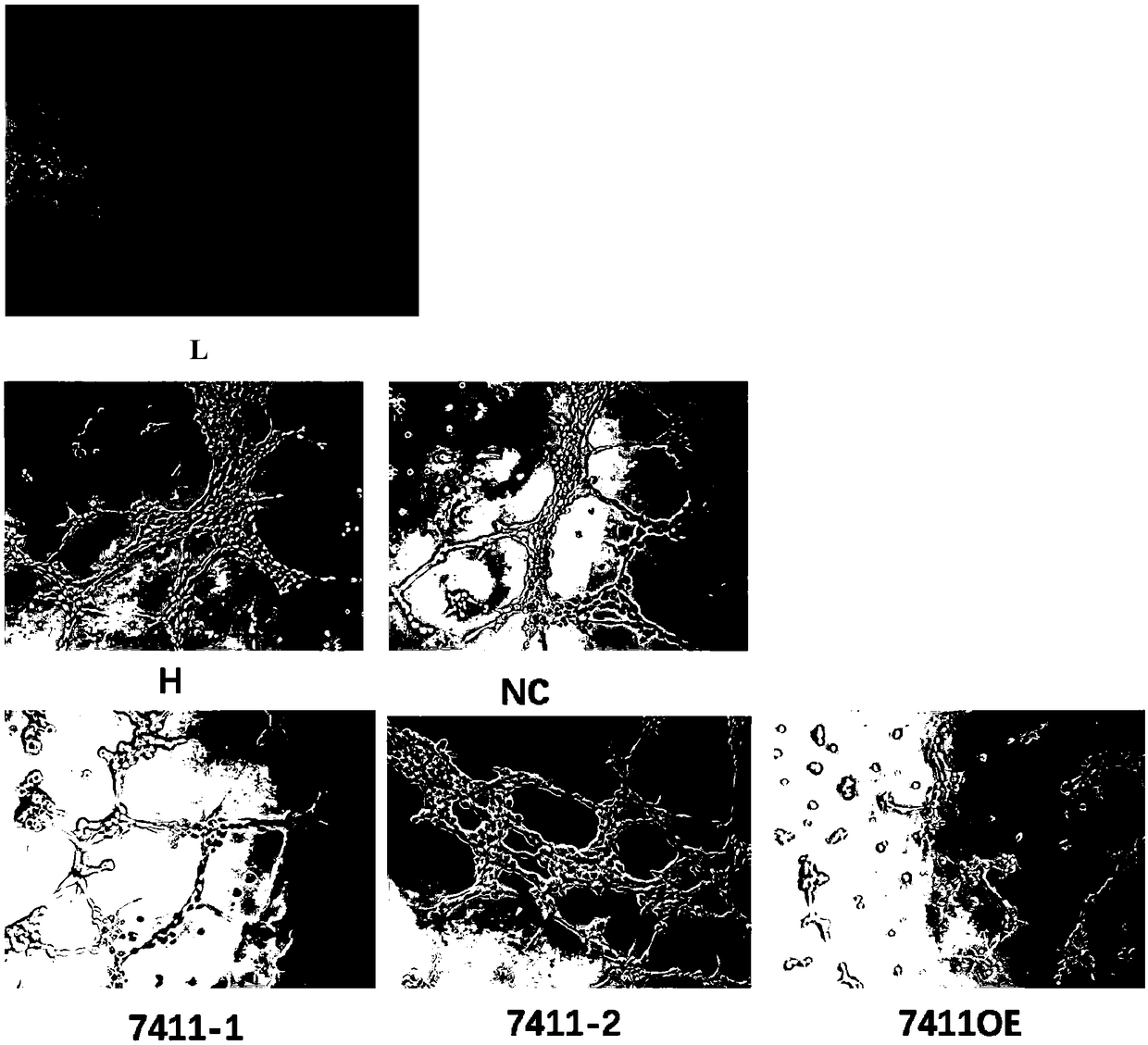Application of circRNA in field of angiogenesis inhibition
A technology of angiogenesis and neovascularization, which is applied in the fields of molecular biology, medicine, and biochemistry, and can solve problems such as ambiguity of circRNA
- Summary
- Abstract
- Description
- Claims
- Application Information
AI Technical Summary
Problems solved by technology
Method used
Image
Examples
Embodiment 1
[0024] Table 1 Primer Sequence
[0025]
[0026] Circ-0007411 interference fragment and overexpression plasmid construction: circ-0007411 interference fragment design: The siRNA sequence shown in Table 1 was synthesized in Suzhou Gemma Company. Overexpression vector construction: Synthesize the complete linear sequence of circ-0007411, anneal the sequence into a double-stranded DNA fragment, and insert it into the LV-Circ vector through multiple cloning sites. The recombinant plasmid is identified by sequencing, and the Control negative control is the LV without the inserted sequence -Circ empty vector. Take 10 μl of transfection reagent Lipofectamine2000 and mix with 100 μl of serum-free and antibiotic-free opti-MEMI medium to form a solution. Mix 10 μl of diluted siRNA with 100 μl of serum-free and antibiotic-free opti-MEMI medium to prepare a solution. After the above two solutions were placed at room temperature for 5 minutes, they were thoroughly mixed, and after sta...
Embodiment 2
[0031] Make a well-shaped mark on the bottom of a 35mm culture dish with a marker pen in advance, and inoculate and culture human retinal microvascular endothelial cells. When the cell density is close to 100%, use a 10μl pipette tip to mark the scratch according to the well-shaped mark. After washing with PBS, replace the medium, and at 0h , 24h to take pictures, and use ImageJ to measure the edge distance change. The results of the cell scratch test showed that when the cell scratch spacing in each group was approximately equal at the initial time, after 24 hours, figure 1 It shows that the wound healing distance of 7411OE group is (134.4±45.4) μm, and the scratch healing distance of 7411-2 group is (330.0±23.1) μm. The healing speed of the 7411OE group was significantly lower than that of the other groups, and the difference was statistically significant (t=8.25, P<0.01). The healing speed of the 7411-2 group was significantly higher than that of the other groups, and the ...
Embodiment 3
[0033] After each group of Example 1 was transfected according to the conditions, 600 μl of DMEM medium was added to each well of a 24-well plate, and at the same time, it was placed in a transwell chamber with a pore size of 8.0 μm, and 200 μl of 1×10 4 Culture of individual retinal microvascular endothelial cells in FBS-free medium. After 48 hours, discard the medium in the upper and lower chambers, wipe the cells in the upper chamber with a cotton swab, add 600 μl of 0.4 g / L paraformaldehyde to the 24-well plate, fix at room temperature for 30 minutes, discard the paraformaldehyde, wash the back of the chamber twice with PBS, and use a 24-well plate Add 600 μl of crystal violet, stain at room temperature for 20 minutes, wash the back of the chamber twice with PBS after aspirating, observe and take pictures under a microscope, and randomly select 5 fields of view for cell counting.
[0034] like figure 2 As shown, the number of outward migration of human retinal microvascu...
PUM
 Login to View More
Login to View More Abstract
Description
Claims
Application Information
 Login to View More
Login to View More - Generate Ideas
- Intellectual Property
- Life Sciences
- Materials
- Tech Scout
- Unparalleled Data Quality
- Higher Quality Content
- 60% Fewer Hallucinations
Browse by: Latest US Patents, China's latest patents, Technical Efficacy Thesaurus, Application Domain, Technology Topic, Popular Technical Reports.
© 2025 PatSnap. All rights reserved.Legal|Privacy policy|Modern Slavery Act Transparency Statement|Sitemap|About US| Contact US: help@patsnap.com



